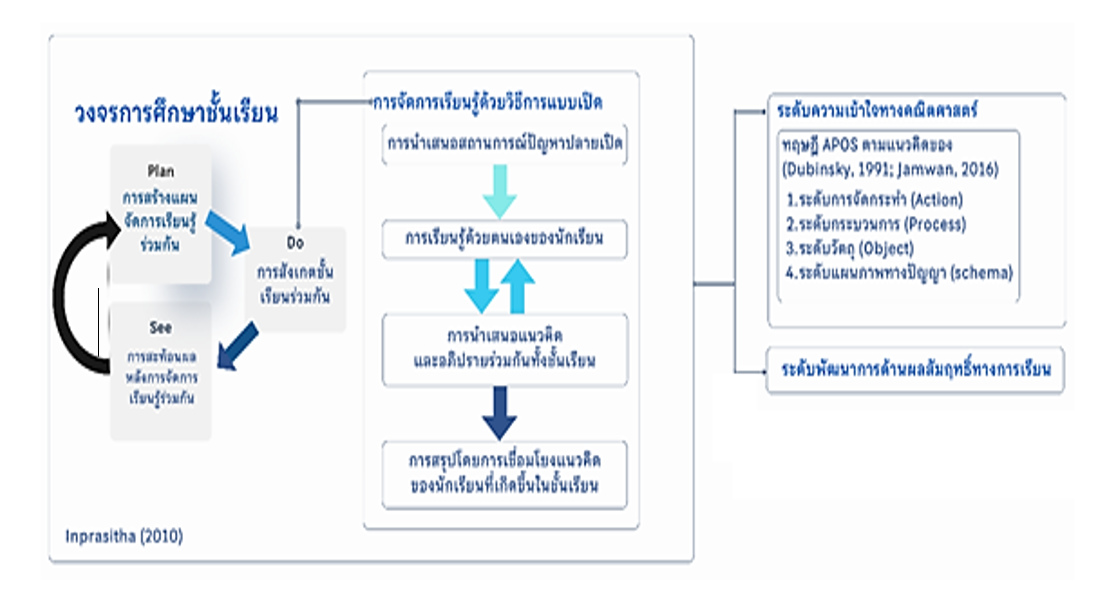Mathematical Understanding on Division of Grade 4 Student in Classroom Using Innovation of Lesson Study and Open Approach
DOI:
https://doi.org/10.14456/jcct.2024.2Keywords:
Mathematical Understanding, Lesson Study, Open Approach, Level of Development of Academic AchievementAbstract
The purposes of the research were to 1) study the level of mathematical understanding on division in 4th grade students and 2) to study the level of development of academic achievement on Division of 4th grade students after learning with open methods. The target group used in the research was 4th grade students at Ban Bueng Kan school total 28 people, obtained from purposive selection. The tools used in the research include learning management plans, field recording form, voice recorder, and academic achievement test. Statistics used in data analysis included basic statistics and content analysis. The research findings showed that: 1) In an open approach, students have mathematical understanding at all levels. When considering inorganizing learning in step 1: presents an open-ended problem situation. Students had an understanding at the action process level, and some have an understanding at the object level. Step 2: self-learning stage, students had an understanding at the action process level and the object level. Step 3: Presenting ideas and discussing ideas together as a whole class, students had an understanding at the process level and object level, and step 4: the lesson summary step from linking student concepts that occur in class, students can connect and have an understanding at the object level as part of the schema. Furthermore, 2) most students have advanced significantly in their mathematical knowledge of division at 53.57 percent.
Downloads
References
1. กระทรวงศึกษาธิการ. ตัวชี้วัดและสาระการเรียนรู้แกนกลาง กลุ่มสาระการเรียนรู้คณิตศาสตร์ (ฉบับปรับปรุง พ.ศ. 2560) ตามหลักสูตรแกนกลางการศึกษาขั้นพื้นฐาน พุทธศักราช 2551. กรุงเทพฯ : ชุมนุมสหกรณ์การเกษตรแห่งประเทศไทย. 2560.
2. ศราวุฒิ จำวัน และ หล้า ภวภูตานนท์. การพัฒนาความเข้าใจทางคณิตศาสตร์เรื่องพาราโบลา ตามแนวคิด APOS โดยใช้โปรแกรม GPS เป็นเครื่องมือ. ขอนแก่น, มหาวิทยาลัยขอนแก่น: เอกสารสืบเนื่องจากการประชุมวิชาการ The National and International Graduate Research Conference 2016; 2559. หน้า 981-988.
3. Pirie SEB and Schwarzenberger RLE. Mathematical Discussion and Mathematical Understanding. Educational Studies in Mathematics. 1988;19:459-470. doi: 10.1007/BF00578694.
4. Pirie S and Kieren. Growth in Mathematical Understanding: How can we characterize it and how can we represent it?. Educational Studies in Mathematics. 1994;26:165-190. doi: 10.1007/BF01273662.
5. Inprasitha M. Lesson Study and Open Approach Development in Thailand: A Longitudinal Study. International Journal for Lesson and Learning Studies. 2022;11(5):1-15. doi: 10.1108/IJLLS-04-2021-0029.
6. Nohda N. Teaching by Open-Approach Method in Japanese Mathematics Classroom. In Proceedings 24th of the Conference of the International Group for the Psychology of Mathematics Education, Nakahara T and Koyama M, Editor. Japan : Hiroshima University. 2000;1:39-53.
7. ธนินท์ วดีศิริศักดิ์ และ เอื้อจิตร พัฒนจักร. การวิเคราะห์ความเข้าใจทางคณิตศาสตร์ของนักเรียนผ่านการแสดงแทน ในลำดับกิจกรรมการสอนการแก้สถานการณ์ปัญหาปลายเปิด. วารสาร มจร สังคมศาสตร์ปริทรรศน์. 2565;11(6): R140-R154.
8. ลัดดาวัลย์ บวรศักดิ์, อาริยา สุริยนต์, สฤษดิ์ ศรีขาว. การพัฒนาความสามารถในการให้เหตุผลทางคณิตศาสตร์ของนักเรียนระดับชั้นมัธยมศึกษาปีที่ 2 ในชั้นเรียนที่ใช้นวัตกรรมการศึกษาชั้นเรียนและวิธีการแบบเปิด. วารสารมหาวิทยาลัยราชภัฏยะลา. 2566;18(3):54-63.
9. ไมตรี อินทร์ประสิทธิ์. กระบวนการแก้ปัญหาในคณิตศาสตร์ระดับโรงเรียน. ขอนแก่น : เพ็ญปริ้นติ้ง. 2557.
10. วิภาวดี บุญไชยศรี. การศึกษาผลการเรียนรู้ทางคณิตศาสตร์ของ ชั้นประถมศึกษาปีที่ 4 เรื่อง จำนวนนับที่มากกว่า 100,000 โดยใช้วิธีการเปิด (Open Approach) จากหนังสือแบบเรียนญี่ปุ่น ในบริบทนวัตกรรมการศึกษาชั้นเรียน (Lesson Study). วารสารชุมชนแห่งการเรียนรู้วิชาชีพครู. 2565;2(1):33-46.
11. เทพธิทัต เขียวคำ และ เจนสมุทร แสงพันธ์. วิธีปฏิบัติเชิงการสอนในการนำแนวคิดทางคณิตศาสตร์เกี่ยวกับการคูณของนักเรียนไปสู่การบรรลุจุดประสงค์ของบทเรียนเรื่องการคูณ: เน้นขั้นการสอนและการสังเกตชั้นเรียนร่วมกันในชั้นเรียนที่ใช้การศึกษาชั้นเรียนและวิธีการแบบเปิด. วารสารศึกษาศาสตร์. 2563;22(4):101-113.
12. ธวัตรชัย เดนชา, เกียรติ แสงอรุณ, ไมตรี อินทร์ประสิทธิ์, สมควร สีชมภู. ความเข้าใจทางคณิตศาสตร์ของนักเรียน เรื่อง เลขยกกำลัง ในชั้นเรียนที่ใช้การสอนด้วยวิธีการแบบเปิด. วารสารวิชาการ Veridian E-Journal, Silpakorn University สาขามนุษยศาสตร์ สังคมศาสตร์และศิลปะ. 2558;8(2):1719-1734.
13. Dubinsky E and McDonald MA. APOS: A Constructivist Theory of Learning in Undergraduate Mathematics Education Research. [Internet]. [Retrieved December 21st, 2023]. Available from: https://www.math.kent.edu/~edd/ICMIPaper.pdf.
14. วิจารณ์ พานิช. วิถีสร้างการเรียนรู้เพื่อศิษย์ในศตวรรษที่ 21. กรุงเทพฯ : มูลนิธิสดศรี–สฤษดิ์วงศ์. 2557.
15. Inprasitha M. One Feature of Adaptive Lesson Study in Thailand: Designing Learning Unit. Gyeongju, Dongkook University: Proceeding of the 45th Korean National Meeting of Mathematics Education; 2010. 193-206.
16. ศิริชัย กาญจนวาสี. การคำนวณคะแนนพัฒนาการ (GainScores). สารสมาคมวิจัยสังคมศาสตร์แห่งประเทศไทย. 2557;1(1):1-20.
17. สุดาพร ติ๊บปาละ และ ศานิตย์ ศรีคุณ. ผลการใช้กิจกรรมการเรียนรู้โดยใช้วิธีการแบบเปิดร่วมกับการฝึกเชิงพุทธิปัญญาเพื่อเสริมสร้างการคิดวิเคราะห์ของนักเรียนชั้นมัธยมศึกษาปีที่ 3 โรงเรียนวังเหนือวิทยา จังหวัดลำปาง. วารสารมหาวิทยาลัยราชภัฏยะลา. 2565;10(1):61-85.
18. ซูฟูวัน เจะแต และ เอกรินทร์ สังทอง. การนำนวัตกรรมการศึกษาชั้นเรียนและวิธีการแบบเปิด สู่การปฏิบัติในสถานศึกษากรณีศึกษา: โรงเรียนประถมศึกษา สังกัดสำนักงานการศึกษาเอกชนจังหวัดสงขลา. วารสารมหาจุฬานาครทรรศน์, 2566;10(3):63-80.
19. อริษา คำโหมด และ สิทธิพล อาจอินทร์. การพัฒนาความสามารถในการแก้ปัญหาทางคณิตศาสตร์ ของนักเรียนชั้นมัธยมศึกษาปีที่ 6 โดยการจัดการเรียนรู้ด้วยวิธีการแบบเปิด (Open Approach) ร่วมกับกระบวนการแก้ปัญหาของโพลยา (Polya). วารสารศึกษาศาสตร์ ฉบับวิจัยบัณฑิตศึกษา มหาวิทยาลัยขอนแก่น. 2562;13(2):95-105.

Downloads
Published
How to Cite
Issue
Section
Categories
License
Copyright (c) 2024 Journal of Computer and Creative Technology

This work is licensed under a Creative Commons Attribution-NonCommercial-NoDerivatives 4.0 International License.





























